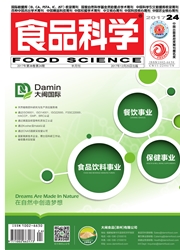

 中文摘要:
中文摘要:
目的:对影响牡蛎酶解产物与还原糖美拉德反应产物(Maillard reaction products of oyster enzymatic hydrolysates and reducing sugar,MRPs-OEH)风味的因素进行优化,得出最佳的美拉德反应条件,并对其风味进行评价.方法:以感官评分为指标,通过Box-Behnken响应面法优化牡蛎酶解产物与还原糖的美拉德反应条件,根据单因素试验结果,采用响应面分析法确定最优工艺参数,采用电子鼻和气相色谱-质谱联用技术对新鲜牡蛎(fresh oyster,FO)、牡蛎酶解产物(oyster enzymatic hydrolysates,OEH)和最优工艺条件下制备的牡蛎美拉德反应产物(optimal Maillard reaction products of oyster enzymatic hydrolysates and reducing sugar,OMRPs-OEH)的风味物质进行比较分析.结果:牡蛎酶解产物与还原糖美拉德反应的最适条件为反应时间29.43 min、反应温度114.62℃、反应初始pH 6.97、OEH与还原糖(木糖-葡萄糖质量比2∶1)质量比1∶1,在此条件下MRPs-OEH的综合感官评分为20.88,和预测值20.25比,相对误差约为3.08%.进一步用气相色谱-质谱联用技术对FO、OEH和OMRPs-OEH的风味物质进行分析,分别检出30、36种和45种风味化合物.OEH中的主要挥发性成分如癸醛、壬醛、正辛醛、(Z)-2-癸烯醛等,使牡蛎酶解液呈现出腥味、哈喇味和油脂味,经过美拉德反应后,主要挥发性成分变成二甲基三硫醚、二甲基二硫醚、(Z)-4-庚烯醛等,它们综合体现了OMRPs-OEH的贝香味、肉香味和海鲜味,同时产生了一些吡嗪类物质,赋予了其一些坚果-肉香味.结论:美拉德反应不仅改善了牡蛎酶解产物的风味,也为新型牡蛎调味品的开发提供了依据,具有极大的经济和社会价值.
 英文摘要:
英文摘要:
Objective: To optimize the Maillard reaction conditions for oyster enzymatic hydrolysates and reducing sugar based on sensory evaluation of Maillard reaction products (MRPs). Methods: The optimization was carried out using response surface methodology based on Box-Behnken experimental design. Electronic nose and gas chromatography-mass spectrometry were employed to analyze the volatile flavor compounds of fresh oyster (FO), oyster enzymatic hydrolysates (OEH), optimal Maillard reaction products from oyster enzymatic hydrolysates and reducing sugar (OMRPs-OEH). Results: The optimal reaction conditions were found as follows: extraction time, 29.43 rain; temperature, 114.62 ~C; pH, 6.97; and ratio of enzymatic hydrolysates to reducing sugar (glucose:xylose = 1:2), 1:1. Under these conditions, the experimental value of sensory evaluation score was 20.88, compared to the predicted value of 20.25. The relative error between the experimental and predicted values was 3.08%. A total of 30, 36 and 45 components were identified from FO, OEH and OMRPs-OEH by GC-MS, respectively. The main volatile compounds of OEH were oetanal, nonanal, decanal and (Z)-2-decenal, which were responsible for the unpleasant smells such as fishy, rancid, and oily. After the Maillard reaction, dimethyl disulfide, trimethyl disulfide and (Z)-4-heptenal became the main volatile compounds, which contributed to the shellfish, meat and seafood flavors. Meanwhile, pyrazine substances were formed, which were responsible for some nuts-meat flavors. Conclusions: The Maillard reaction not only can improve fishy odor of OEH, but also can develop a new oyster flavoring agent, which has highly economic and social value.
 同期刊论文项目
同期刊论文项目
 同项目期刊论文
同项目期刊论文
 期刊信息
期刊信息
